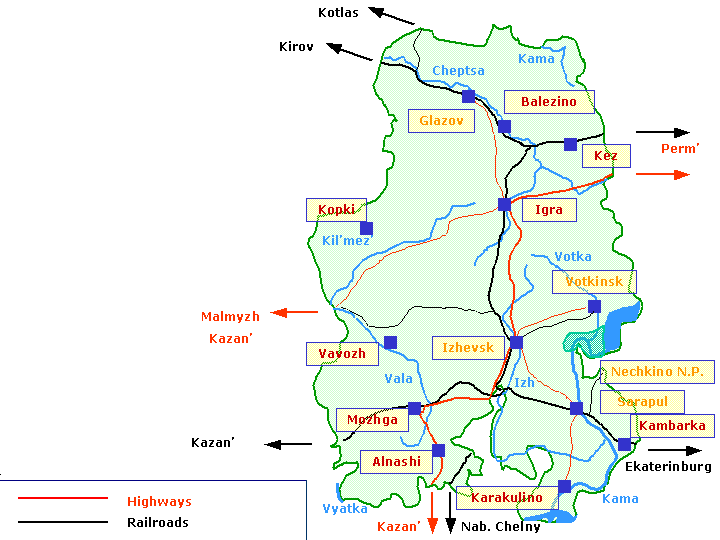

Udmurt Republic — 18rus

| General | ||||||||||||||||||||||||||||||||||||||||||||||||||||||||||||||||||||||||||||||||||||||||||||||||||||||||||||||||||||||||||||||||||
|
Udmurt Republic (Udmurtia, 18rus), center — Izhevsk. Situated in the Northeast of the European part of Russian Federation, West of Ural mountains, in the basin of rivers Kama and Vyatka. About half of the area is covered by woods (conifers and mixed forests). In the far South oil fields are developed. Principal rivers — Kama with the right tributaries Votka and Izh, and Vyatka with the left tributaries Cheptsa and Kil'mez'. Official languages of the Republic are Russian and Udmurt. About 60 percent of the population are Russian and 30 percent are Udmurt. Approximately two thirds of all Udmurts (formerly known as Votyak) live in the Republic; others are dispersed mostly in neighboring regions — Kirov, Perm' Regions, Tatarstan, and Bashkiria. Udmurt language is spoken by some 460 thousands (2002). It belongs to the Perm-Finnic group of Finno-Ugric family of languages. This means it is as close to Estonian and Finnish as say Spanish to English. The most closely related language is Komi. Linguists distinguish three dialects of Udmurt — Northern, Southern, and Besermyan (the latter is widespread in the North-West of the Republic in the basin of River Cheptsa). Udmurt is written on the basis of Cyrillic script, a number of newspapers are published, radio and TV broadcast part-time in Udmurt. A majority of native speakers are however elderly people, and the Udmurt language made it to the UNESCO list of endangered languages. A number of Udmurt native speakers currently decreases. The majority of Udmurts are Russian Orthodox, but many preserved pagan pre-Christian beliefs. Finno-Ugric tribes populated the area of modern Western, Northern, and Central Russia since prehistory. The archaeological sources discovered at the territory of modern Udmurtia date from 8th century BC. Udmurts are mentioned in Muslim (Arab) sources from 12th century, and in Russian ones from 14th century (earlier Russian chronicles mention Perm which is apparently a common name of all Finnic tribes of Cis-Urals). Northern Udmurts at the time were already a part of Vyatka Territory — a frontier region formed in the course of Russian colonization of the North. Together with this territory, in 1489 they were annexed by Moscow Principality. Earlier, Southern Udmurts allied with Volga Bulgar state, which was situated at the territory of modern Tatarstan and was destroyed in 1236 by the Mongol troops of Batu-khan, advancing to Russia. After the fall of Volga Bulgars, Southern Udmurts entered the Golden Horde, the Mongol (later Tartar) state, and after the Golden Horde split out, they remained under the khan of Kazan'. In 1552, after Kazan' was taken by the troops of Ivan the Terrible, they also ended up in the Russian State. Until 18th century, Udmurt lands were so far from any kind of civilization that they did not really interest anyone. From 1740s the state starts some activity: First, forcible christianization of Udmurts, then industrial construction. The first to be built in 1756 was Bemyzh copper-melting works; in 1760 Izhevsky Zavod (Izhevsk works) was founded. In 1780, Vyatka Governorship was created, and in the same year 1780 the first two settlements — Glazov and Sarapul - obtained the (district) town status. Udmurts constituted the majority of the population of four districts and were designated to be state peasants. In 1775 the first scientific Udmurt grammar was published. After the 1917 October revolution, in 1920, Votyak (since 1932, Udmurt) autonomous region was formed. From 1934 it was known as Udmurt Autonomous Republic, and from 1991 — Udmurt Republic. In 1970s population migrated massively from the republic, many Udmurt villages were declared to have no prospective; their inhabitants were resettled to cities and towns. Currently, Udmurts are in minority in the republic, and the state basically does not stimulate interest in the Udmurt language. Two principal railway lines run through the Republic: Moscow - Kirov - Ekaterinburg in the North and Moscow - Kazan' - Ekaterinburg in the South. These two are connected by a secondary railroad that passes through Izhevsk. Federal highway M7 Moscow - Kazan' - Izhevsk - Perm'. Passenger and cargo navigation on Kama. |
||||||||||||||||||||||||||||||||||||||||||||||||||||||||||||||||||||||||||||||||||||||||||||||||||||||||||||||||||||||||||||||||||
| What to see | ||||||||||||||||||||||||||||||||||||||||||||||||||||||||||||||||||||||||||||||||||||||||||||||||||||||||||||||||||||||||||||||||||
|
||||||||||||||||||||||||||||||||||||||||||||||||||||||||||||||||||||||||||||||||||||||||||||||||||||||||||||||||||||||||||||||||||
| Additional Resources | ||||||||||||||||||||||||||||||||||||||||||||||||||||||||||||||||||||||||||||||||||||||||||||||||||||||||||||||||||||||||||||||||||
Udmurt Republic
English:
Russian:
Udmurt ethnos and language
English:
Russian:
Resources for individual attractions English:
Russian:
|
||||||||||||||||||||||||||||||||||||||||||||||||||||||||||||||||||||||||||||||||||||||||||||||||||||||||||||||||||||||||||||||||||
Author of this page: Yaroslav Blanter. Last updated: 16.09.09.
2004—2009 © Guide to Russia (Authors). All Rights Reserved.